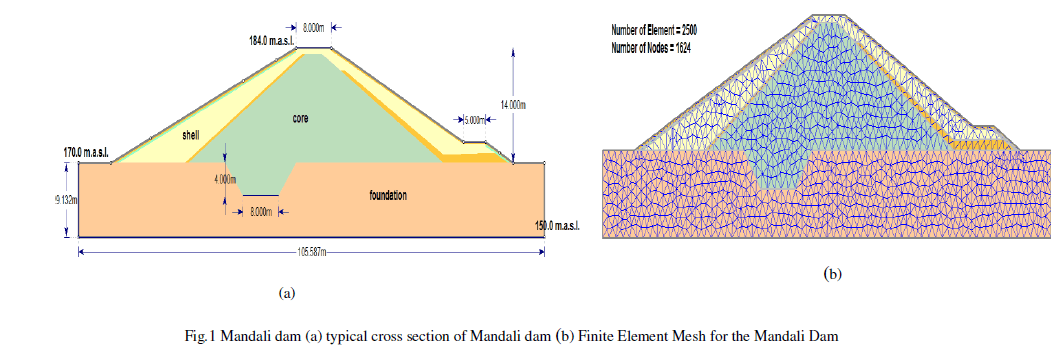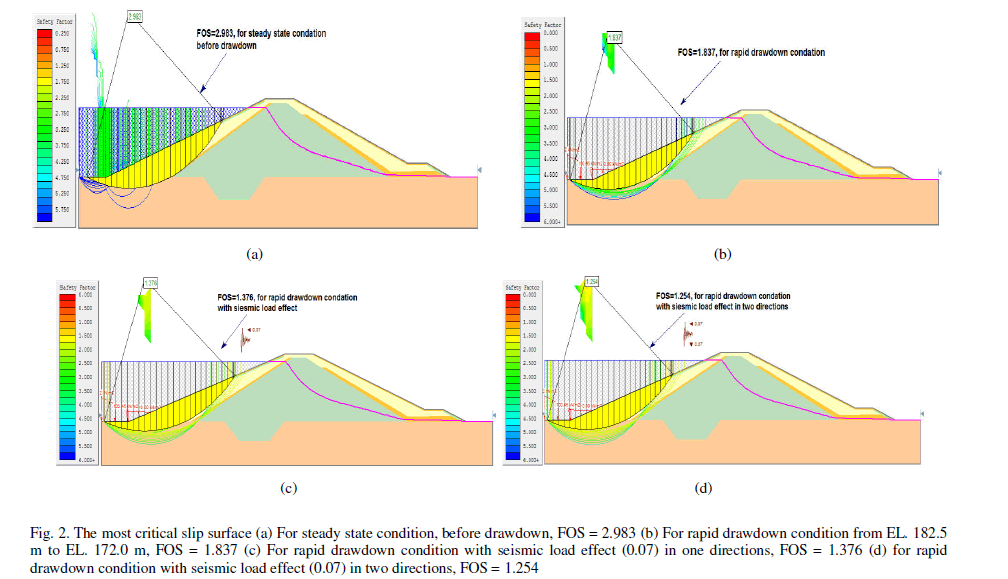ISSN ONLINE(2319-8753)PRINT(2347-6710)
ISSN ONLINE(2319-8753)PRINT(2347-6710)
Prof. Dr. Saleh I. Khassaf1, Dr. Maha Rasheed Abdoul- Hameed 2, Nabaa Noori Shams Al-deen3
|
| Related article at Pubmed, Scholar Google |
Visit for more related articles at International Journal of Innovative Research in Science, Engineering and Technology
The one of the most dangerous conditions of earth dams for the upstream side slope is rapid drawdown condition when the countervailing upstream water pressure has disappeared, it causes a danger to the upstream slope. In this work, by applying the Morgenstern-Price presented by the computer program SLIDE V.6.0 is applied to define the potential slip surface and calculate the factor of safety of zoned earth dams (Mandali dam in Iraq) under rapid drawdown condition for maximum elevation with seismic forces effects. It founded that the stability of the upstream slope of Mandali dam is dramatically decreased but still in stable during rapid drawdown condition.
Keywords |
| Earth Dam, The finite element, Morgenstern-Price method, factor of safety, Seismic force, side slope stability, paid drawdown |
I. INTRODUCTION |
| Stability analysis during rapid drawdown is an important consideration in the design of embankment dams. During rapid drawdown, the stabilizing effect of the water on the upstream face is lost, but the pore-water pressures within the embankment may remain high. As a result, the stability of the upstream face of the dam can be much reduced. The dissipation of pore-water pressure in the embankment is largely influenced by the permeability and the storage characteristic of the embankment materials. Highly permeable materials drain quickly during rapid drawdown, but low permeability materials take a long time to drain. |
| In order to lower the phreatic line and pore water pressure as well as the hydrodynamic pressure in the upstream shell, drains in the upstream slope’s base and at the intermediate level should be installed, if appropriate. These upstream drains are capable of draining the upstream slope and making the equipotential lines tend to become horizontal. They have a very significant effect on the stability of the upstream slope during drawdown [Tran, 2008]. |
| Traditional limit equilibrium methods will be utilized in the slope stability analysis and the accommodation of saturated and unsaturated pore-water pressures will be considered (Fredlund and Feng (2011)) |
| In this study, a finite element software, SLIDE V.6.0 computer program , is used to determine phreatic line and factor of safety. SLIDE is2D limit equilibrium slope stability program for evaluating the safety factor or probability of failure, of circular or non-circular failure surfaces in soil or rock slopes. Slide analyzes the stability of slip surfaces using vertical slice limit equilibrium methods although the Slide groundwater analysis is geared towards the calculation of pore pressures for slope stability problems |
| The drawdown is known as one of the most dangerous conditions for the upstream side slope. When the countervailing upstream water pressure has disappeared, it causes a danger to the upstream slope. The upstream shell cannot stay stabile under the hydrodynamic pressure due to rapid drawdown. Soils inside the dam body remain saturated and seepage commences from it towards the upstream slope. Seepage and hydrodynamic pressures create downward forces acting on the upstream slope. Those are adverse to the stability and create a critical condition to the upstream slope. The Rapid Drawdown Condition occurs when a slope that is used to retain water experiences a rapid (sudden) lowering of the water level and the internal pore pressures in the slope cannot reduce fast enough. |
| Excess pore pressure refers to changes in pore pressure within a soil due to rapidly drawdown of pounded water in upstream side conditions (undrained loading). Materials with low permeability such as clays, may exhibit this behavior. With the so-called "B-bar" method, the change in pore pressure is assumed to be directly proportional to the change in vertical stress. The excess pore pressure is given by : |
 |
| From equation (1), it can be noting that the value of the excess pore pressure is dependent on the value of (B-bar) coefficient. The value of (B-bar) coefficient is dependent on the type of soil and properties of soil. If (B-bar) coefficient is defined about 0, the soil is free to drain and no excess pore water pressure is developed in upstream side. If (B-bar) coefficient is defined about 1, the undrained condition is applied and excess pore pressure is developed in upstream side. The value of (B-bar) coefficient close to 1 represents critical condition of rapid drawdown in upstream side and should be selected to any soils which have low permeability |
II. MORGENSTERN AND PRICE’S METHOD |
| The the Morgenstern-Price method was developed by Morgenstern and Price (1965), which considers not only the normal and tangential equilibrium but also the moment equilibrium for each slice in circular and non-circular slip surfaces. In this method, a simplifying assumption is made regarding the relationship between the interslice shear forces (X) and the interslice normal forces (E) as: |
 |
 |
| This method of slope stability analysis, which is valid for slip surfaces of any arbitrary shape, is considered as the more general rigorous method [Baker, 1980]. It stems its generality from the fact that no stringent restriction is imposed neither on the direction or location of the interslice forces nor on the shape of the slip surface analyzed [Al -Jorany, 1996]. |
| Seismic activity is associated with complex oscillating patterns of accelerations and ground motions, which generate transient dynamic loads due to the inertia of the dam and the retained body of water. Horizontal and vertical accelerations are not equal, the former being of greater intensity. For design purposes both should be considered operative in the sense least favourable to stability of the dam. Horizontal accelerations are therefore assumed to operate normal to the axis of the dam.(Novak and Nalluri,(2007)) |
| If seismic coefficients are defined, a seismic force will be applied to each slice as follows: |
| Seismic Force = Seismic Coefficient * Slice Weight . . . . . . . (8) |
| From this definition it can be observed that the seismic force increases when slice weight increases. |
III. CASE STUDY |
| The Mandali Dam is one of an earth fill dams in Iraq, which had been designed by Directorate General of Dam and Reservoirs. Which is located on Harran Wadi, in the governorate of Diyala which is extends to the northeast of Baghdad. The dam site is situated upstream Koma sang pipe line headwork.the area of the dam is bounded by the following coordinates (373700-378500) N, (554500-565000) E. The dam is a low dam, which acts in most of its parts as a submerged weir. The Wadi bed is gravely and permeable to some depth as it is clear from geological investigation Mandali dam with a central core total length of the dam is about (1316 m) and its maximum height is about (14m). The shell, which is composed mainly of poorly graded gravel with high percentage of coarse gravel , and the central core, the investigation and laboratory testing show clay the available materials at site as a construction material for core (Directorate General of Dams and Reservoire,(2004)). |
| The finite element mesh used in this analysis is as shown in figure (1); 3 node triangles elements are used to describe the domains. The mesh contains 2500 element and 1624 node; The first step in our analysis are concerning about selected the numbers of element and selected these value when the number of element became independents of solution, in this case any increment in the number of element dose not effected on the values of solution in domain of analysis the number of elements is selected from mesh generation from change in phreatic surface |
 |
IV. ANALYSIS AND DISCUSSION |
 |
| The slope stability against landslide risk is represented by safety factor (SOF), which is determined using Morgenstern-Price Method. The slope stability in the rapid drawdown was examined. In a rapid drawdown of water level, deformation and crack occurred in the dam model at the upstream slope. The failure process in the rapid drawdown of water level was begun with movement of soil particles in the surface of upstream slope model. |
| Above figure (2) shows, (a) the value and location of most critical slip surface for steady state condition (before drawdown). (b) the value and location of most critical slip surface for rapid drawdown condition from EL. 182.5 m to EL. 172.0 m. (c) and (d) show the value and location of most critical slip surface for rapid drawdown condition with seismic load(0.07g) effect for one and two direction. It show that the value of factor of safety of upstream decrease when rapid drawdown condition and seismic load effect |
VI. CONCLUSION |
| In this study, a finite element software, SLIDE V.6.0 is used to determine the factor of safety under rapid drawdown condition from EL. 182.5 m to EL. 172.0 m and rapid drawdown condition with seismic load (0.07g) effect for one and two direction. It is found that the factor of safety of upstream decrease when rapid drawdown condition and seismic load effect and the upstream slope is still stable during rapid drawdown, and the minimum value obtained for FOS is about 1.254 during rapid drawdown and seismic load coefficient 0.07. |
References |
|